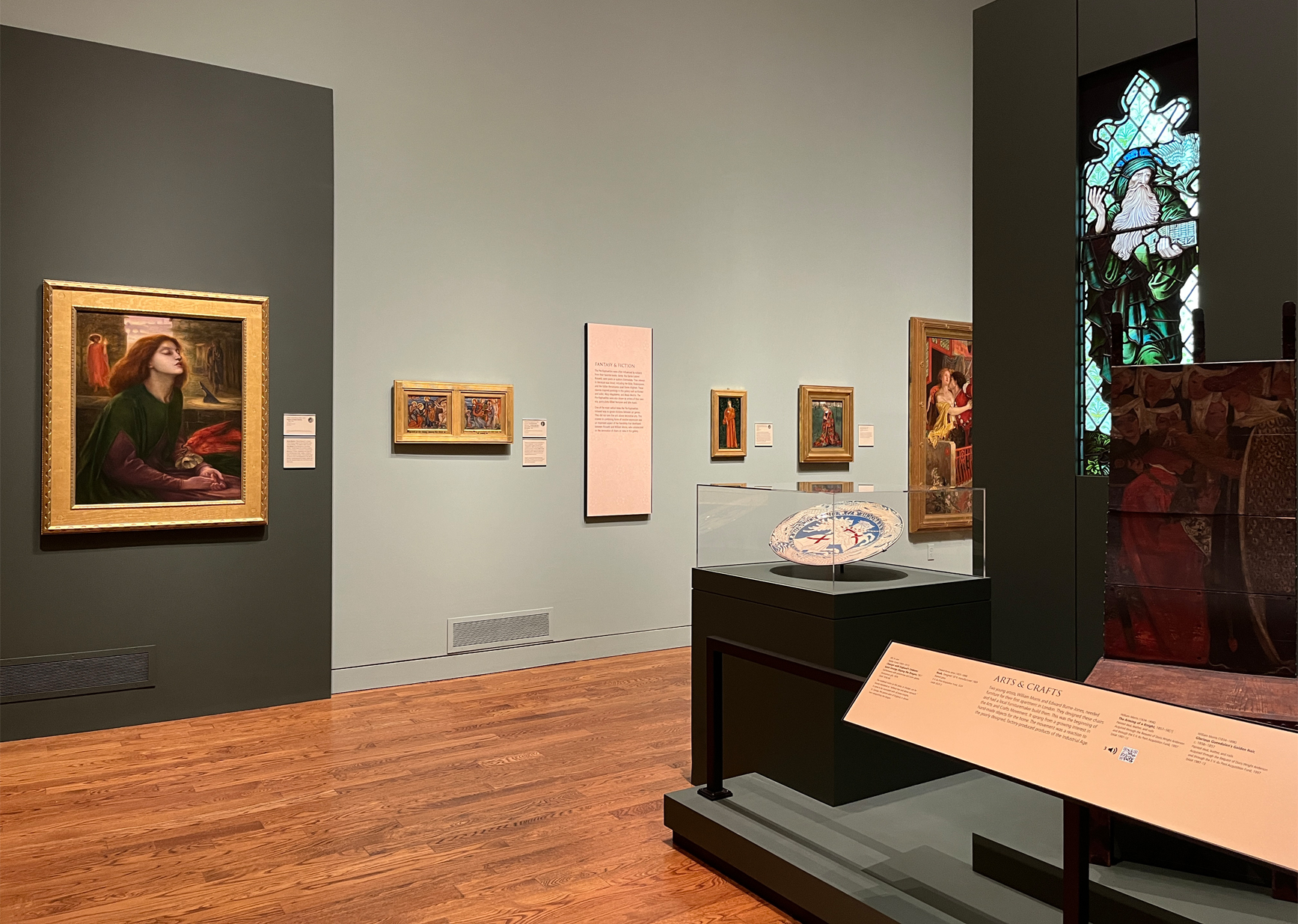In Fall 2023, the Delaware Art Museum was delighted to receive a generous grant from the Dr. Lee MacCormick Edwards Charitable Foundation to incorporate new acquisitions by women artists into our permanent Pre-Raphaelite galleries. The Pre-Raphaelites are popularly known for their paintings of women, who were in decades past referred to as “stunners.” The label, now understood to be pejorative and objectifying, addressed these women’s appearances and not their skills or talents. Pre-Raphaelite models had vibrant, creative lives. Some were even artists themselves. The new display in the Pre-Raphaelite galleries features a number of new acquisitions by women artists alongside works by women artists and makers that have long been in DelArt’s collections. Read more for a sneak peek!
Maria Zambaco’s Irresistible Love

Maria Zambaco was a British artist and model of Greek descent. She was favored by the Pre-Raphaelites, particularly by Dante Gabriel Rossetti and Edward Burne Jones. She was also a childhood friend of artist Marie Spartali Stillman and part of the community of wealthy expatriate Greeks in London. Today Zambaco is remembered for her tumultuous affair with Edward Burne-Jones, which scandalized London. This part of her biography, however, has overshadowed her artistic output. Zambaco was an artist in her own right, having studied with French sculptor Auguste Rodin. This recent acquisition, L’Amour Irresistible (“irresistible love”), is Zambaco’s best-known work. She represents Cupid in motion, stringing his bow. The title is perhaps a reference to her earlier relationship with Burne-Jones. Several versions of this delicate composition survive, in both bronze and in spelter, the medium here, which is a zinc-lead alloy that ages to resemble bronze.
A New Diptych by Phoebe Anna Traquair

Phoebe Anna Traquair was a versatile Irish-born, Edinburgh-based artist who worked in a range of media. She produced paintings, murals, illumination, calligraphy, embroidery, jewelry, and watercolors. DelArt has recently enlarged its holdings of works by Traquair with this pair of oil paintings, which are among the religious pieces the artist completed in the 1880s. Both panels represent scenes from the New Testament’s Book of Luke. The right panel depicts a moment shortly after the Virgin Mary is told she will bear the child of God. The left panel shows a later scene when Jesus’s disciples discover he has risen. The figures’ expressive faces and gestures, the use of gold paint, and the bold colors indicate that Traquair was influenced by medieval illuminated manuscripts.
We are delighted to add this diptych to the collection, in large measure because of its religious imagery. Such imagery was central to the Pre-Raphaelite movement but is not well represented in DelArt’s core Pre-Raphaelite holdings. This is because religious subjects were not of particular interest to Samuel Bancroft, who assembled the museum’s founding Pre-Raphaelite collection.

Traquair’s diptych is installed nearby a lovely enamel pendant by the artist, The Song, which has been in the collection since 1976. The trio of angels depicted in this pendant illustrates the artist’s deft, refined technique. She referred to her enamels as “little lyrics,” an apt descriptor given the subject of this work.
An Artist with a Growing Reputation

Alice Boyd was a Scottish artist associated with the Pre-Raphaelite circle whose output is not well known, largely due to the fact that she barely exhibited during her lifetime and many of her work works remain in private collections. St Columba’s Farewell to the White Horse (1868) joined DelArt’s collection is 2011 and is on view in our new installation. The subject of this painting is the medieval Irish missionary monk, St. Columba, shown in his exile in Scotland. He bids farewell to an aged white pack horse which, having had a premonition of the saint’s death, has come to receive his blessing.
This work was an important addition to the collection over a decade ago, not only because the work was produced by a woman, but also because it grows the number of Pre-Raphaelite landscapes in our holdings, which is among the lightest Pre-Raphaelite genres due to Samuel Bancroft’s own lack of interest in landscapes. Alice Boyd’s reputation is today on the rise. In 2021, Boyd’s name made headlines when one of her oil paintings sold at auction for ten times its high estimate. While you may not be able to afford a Boyd of your own, come visit ours in our Pre-Raphaelite galleries!
Sophie Lynford
Annette Woolard-Provine Curator of the Bancroft Pre-Raphaelite Collection
The Delaware Art Museum thanks the Dr. Lee MacCormick Edwards Charitable Foundation for their generous support of this installation on women artists in our Pre-Raphaelite Galleries.


